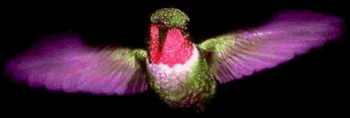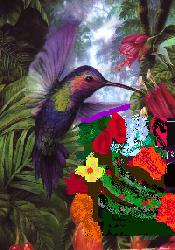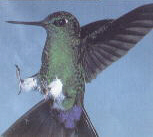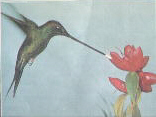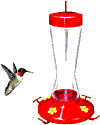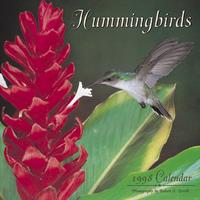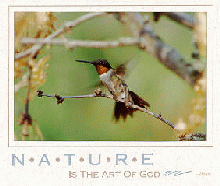The ruby-throated hummingbirds are fearless little birds who constantly guard there territory. They are very tiny, only about 3 inches long. Their beaks and their tongues are so long that they are able to get the sweet nectar from deep down in the flowers. They get many small insects along with the nectar. They will attack any other bird that tries to impose upon their feeders and also is a wonder of migration that is hard to believe. Although ruby-throated hummingbirds are very small, they are expert flyers. They can fly forward, backward, or straight up and down. By keeping their wings moving very fast, they can also poise in mid air. The hum which comes from the rapid beating of their wings entitles them to their name. Their feet are frail and are used only for perching on fine twigs. These tiny birds never run or even walk. Every winter it makes an amazing journey. For several days it eats continually, storing food and energy in its tiny body. Then it will fly for many days, battling the elements, to get to a warm climate. Some have been known to make a journey of thousands of miles, from Canada to the Southern hemisphere. They store up enough energy to accomplish such lengthy journeys for weeks previous to their flight. However, scientists are still unable to explain how they manage this migration,and because of it the hummingbird is a symbol for accomplishing that which seems impossible.
It is an inspiration on how to enjoy the pleasures and joyful living from your own life circumstances.
The Ruby Throated Hummingbird has a beautiful iridescent green back and wings and a brilliant red throat. The female has none of the red markings on its gorget.
Hummingbirds feed on flower nectar and insects. You can purchase
hummingbird nectar that comes in the form of a sugar like substance that when added to water makes a red nectar. However, I prefer to make my own nectar with 1 part sugar to 4 parts water and I add just a few drops of raspberry or strawberry juice. Clean the feeders regularly each week.
Hummers have and require an enormous amount of energy. Their hearts can beat over l200 beats per minute. Their wings beat faster than any other bird.
Hummingbirds visit several hundred flowers per day. They are very territorial and are wicked when it comes to protecting their feeders or flowers. It is a good idea to put feeders a good distance from each other if you want to accommodate several hummers.
I hang the feeders under a huge cedar tree where it remains shaded most of the day. I also have one with a suction cup that is right on my bay window where I dine. They seem to be curious little creatures. I often wonder, while watching these marvelous little birds, do they fly south by themselves? I have seen them still in the north on October 10th and wonder do they hitch rides on the Canada Geese for their southern trek, as reported, or do these tiny little birds really fly south on their own energy. They are marvelous and very interesting little birds and each summer never seem to cease to amaze me.
Hummingbirds do not mate for life. They have several mates over a lifespan of approximately 15 years. The female raises the young on her own.
Here's another great reason to attract hummingbirds to your backyard:
They eat aphids, spiders and gnats!
.....and you thought they were just fun to look at!
I received the following email from Wild Birds Forever
We have had many concerned inquiries regarding when to take down your
hummingbird feeders, so we thought we'd share some info on this with you.
Contrary to popular belief, leaving your hummingbird feeders up will not
interfere with hummingbird migration. All birds migrate based on hormonal
changes brought on by changing daylight hours.
In fact, hummingbirds can readily use the energy found at backyard
hummingbird feeders as they begin their long migration journeys.
We advise taking your feeder down when you feel comfortable or wait until
you no longer see hummingbirds feeding for several weeks.
P.S. those of you living in the lower elevations of the Southwest can relax
and enjoy those hummers all year long!
THIS FRIENDLY BIRD TIP BROUGHT TO YOU BY YOUR FRIENDS,Wild Birds Forever!
Click for more about hummingbirds on Cam
|

